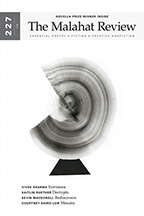Publishing Tips
The Professor of Astonishment

March's Publishing Tip comes to you from Kateri Lanthier, a Canadian writer whose work has appeared in numerous literary magazines across the country. Her poem, “The Coin Under the Leftmost Sliding Cup,” won the 2013 Walrus Prize, appeared in The Best of Walrus Poetry, and was included in Best Canadian Poetry 2014 (Tightrope Books). Her second poetry collection is forthcoming from Signal Editions, Véhicule Press in 2017.
The subway ride from the east end of Toronto, where I live, to the far west end was absurdly long. It was followed by the “express” bus trip, a 40-minute journey along strip development—Sri Lankan grocery stores, pho restaurants, car dealerships, apartment towers—that culminated in a burst of green as we descended into the Credit River valley. Set at the edge of Erindale Park, the campus of the University of Toronto Mississauga (UTM) is nearly bucolic. Deer roam freely. I found the room in which I was to begin teaching creative writing for the first time. It gradually filled with students. Quiet and attentive, most had that inward-looking aspect that often characterizes people who like—or feel compelled—to write. What would I tell them, read to them, hear from them, this class of fifteen students aged 19 to 21?
In our windowless lecture room, there were few distractions. There was nowhere to hide, really, unless you drew up the covers of a book (so to speak). I took a sip of water, greeted the students, and felt the adrenaline surge I experience before giving a poetry reading. I began, “You’re—we’re—in a dialogue with writers past, present and future, with readers of the present and future. You’re part of a continuum ... I want to emphasize that reading and writing are such intertwined activities that they’re almost the same activity. Reading itself is, in my view, creative. And if you want to write, you must read.”
As the academic year has progressed, I’ve reveled in the chance to read, with the students, stellar poems from the history of Eng lit, moving poems in translation—ghazals, haiku—and new work—work that astonishes me and that I feel eager to share—by contemporary poets from Canada and beyond our borders. We started with poetry, with The Making of a Poem (eds. Eavan Boland and Mark Strand) as the central text. I chose it because it offers a substantial number of poems in their entirety and because we were focussing on form. From the beginning, I’ve augmented it with handouts of poems, especially by Canadians—few were included in that anthology—and the 21st C luxury of poems-on-screen, thanks to Internet access in the classroom. In response to work by the students, I not only rely on lines I can quote from memory or locate in a text I have on hand, but can also leap to the keyboard and project a wealth of references to the classroom screen, play short films (such as those on Robert Pinsky’s www.favoritepoem.org) or audio clips (such as those in the Poetry Archive, based in England). We’re into fiction now, discussing the insights of James Wood (How Fiction Works is the main reference text).
We have a “let’s try it” approach: the aspiring fiction writers bravely attempted the villanelle and the sestina; the poets are writing gothic short fiction and first-person reminiscences. The students have often surprised themselves and me. Those who were most adamant in declaring “I’m not a poet!” wrote some of the most moving lines or showed clever mastery of a challenging form. We also leap through centuries. The sonnet class took us from Wyatt to Shakespeare to Keats to Yeats to Sonnet L’Abbé and Sandra Simonds. While I hoped the students would learn from the music and methods of earlier work, I’ve also made sure to keep writing by women and writers of colour central in the course. In addition, I don’t mute my enthusiasm for poetry as a foundation for writing. I think of it as being somewhat like piano lessons for music students or ballet class for dancers. You might move on to other instruments or styles, but you’ll always benefit from your exposure to poems. I brought in a copy of Pale Fire and a copy of Possession to underscore the point. “You, too, could win renown—or even the Booker!—if you’re a novelist who writes poetry!” I joked as I waved the books around and then read from them. But I was only half joking.
To teach an introductory class, it helps to be a generalist. I’ve had to move beyond my preferred genres to help the students. We have aspiring poets, science fiction writers, YA fiction writers, a playwright, online game writers, a graphic novelist, and at least one memoirist. It might seem odd or even presumptuous of a 20-year-old to be writing a memoir. But some people live the experiences of an entire lifetime before they’re 20 and my student with a memoir-in-progress is one of them. I’ll give nothing away here, except to say that I can hardly wait for other people to have the chance to read his work. I also offer the students whatever insights I can into the business side of publishing and the sometimes fraught world of readings, literary feuds, and the future of “the industry.” I have put some in touch with writers they have thought might help them as mentors. We’ve had great class visits from Anna Yin, the inaugural poet laureate of Mississauga, and from the poet and reviewer Phoebe Wang, who wrote about it here.
I include allusions to art, music, journalism, and pop culture, to the extent that I can (it helps that I have a teenager and younger kids at home). During one meeting in office hours, a student and I made references to the work of Flaubert, Ambrose Bierce, Cindy Sherman, Sheila Heti, Lena Dunham, and the Modern Love column in The New York Times. One student’s searing prose poem in response to a prompt I had given branched into a discussion of the work of Claudia Rankine and Robin Coste Lewis. We sometimes end up in tears, a state I recall only rarely from my English studies (indeed, it was so rare in the St. George campus of the University of Toronto, where I did my BA and MA, that I wrote a poem about the single instance I observed). When the students themselves are, in effect, creating part of the syllabus, there’s a whole other emotional dimension at work. We’ve had to ask around for Kleenex. I must remember to bring in a box … Then again, we also seem to laugh more. I was thrilled and the students were beside themselves when one read a blisteringly funny short story the other day, which was a big departure in tone for her. From the beginning, I’ve said that humour—even a small amount—can help to heighten all the other emotional notes in a piece. And I call on the wit of others: the class fell about when I played them the audio clip of Colm Toibin’s advice to beginning writers.
The elegies my students wrote were wistful, awkward, and heartbreaking, even the one from the student who said she hadn’t lost anyone in her life yet and had no one to mourn. I walked out of that class in a reverie. At 20, it’s entirely possible that you might not yet have lost anyone close to you. It’s a state that, as years go on, cannot be maintained. The poignancy of it is poem-worthy.
There were things I didn’t anticipate. We discussed trigger warnings early on and everyone has been respectful of the need to give a heads-up if the emotional tenor or language of a piece might be upsetting. So far, so good. But I didn’t expect that spoiler alerts would be needed! Several of the students write fan fiction, or a hybrid form of it, and are scrupulous about alerting the class to the presence of plot revelations.
I’ve asked the students to keep journals, which I stress are important to have with you at all times. “If you don’t write it down, you’ll forget. And you can find material everywhere, in overheard conversations, on scraps of paper, in signage, etc.” To some of my students, however, “notebook” means “laptop” or “phone.” Some sent me pdfs or downloaded files to demonstrate that they were actually keeping notes.
The students seemed truly amazed when I recited the opening of The Canterbury Tales in Middle English. One student I ran into at the bus stop was astonished (“But all the professors drive cars!”), while another was amazed that I have never been in the elevator in the building that houses the English department (“But I would never take the stairs!” Note: my office is on the third floor.) It might not be all that hard to astonish 20-year-olds, I realize. But I delight in the look of recognition that comes over the students when they seem to think I’ve hit on an especially important point and grab their pens and make notes, or when they respond with awe to another student’s bold story or poem. I’m happy to be the Professor of Astonishment and to have such astonishing students to teach.
* * * * * * * *
The Malahat Review posts “Publishing Tips” as a bimonthly guest column on its ![]() website and in Malahat lite. Follow it in order to learn how to improve your professional skills, from the writing of cover letters, to what house style means, to choosing a rhyming dictionary, to having an author photo (as opposed to a selfie) shot. If you have a Publishing Tip you’d like to share, email The Malahat Review at malahat@uvic.ca, with “Publishing Tip Idea” in the subject line. Tips should be 750 words or less. If yours is accepted, you will be paid an honorarium of $50.
website and in Malahat lite. Follow it in order to learn how to improve your professional skills, from the writing of cover letters, to what house style means, to choosing a rhyming dictionary, to having an author photo (as opposed to a selfie) shot. If you have a Publishing Tip you’d like to share, email The Malahat Review at malahat@uvic.ca, with “Publishing Tip Idea” in the subject line. Tips should be 750 words or less. If yours is accepted, you will be paid an honorarium of $50.









